Read our news:
- Season’s greetings and update from Pangolin’s MD
- Special Broadcasting Service (SBS): on a path to net zero before 2050
- Have a carbon neutral festive season
Missing out on our news? Subscribe to our newsletter.
Season’s greetings
From Iain Smale, Managing Director Pangolin Associates
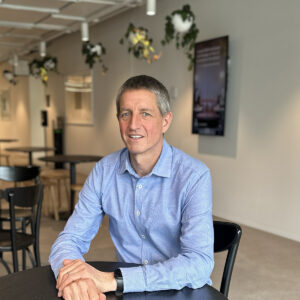
Level 11/10 Carrington Street.
This year has been an exciting one for Pangolin. In September we announced that Pangolin Associates joined the Viridios Group.
Viridios’ investment means that we have additional resources in place to support the growing demand for our consultants and a more decisive shift to services such as Science Based Targets, ESG, ISSB, and Net Zero. Yes, we still provide core services such as carbon footprints and Climate Active, but today these actions are part of the transition to net zero emissions – a milestone rather than an end goal. I invite you to talk to one of our specialists about your organisation’s decarbonisation strategy.
And while we have made substantial changes in 2023, rest assured our values and culture remain the same. We are as committed as always to being a force for good in the world. Proudly, we remain part of the B Corp community and a business member of 1% for the Planet. Last month in our all-of-team selection process we donated 1% of Pangolin’s revenue to five environmental organisations.
In celebration of 2023 and the holiday season, we bring you an inspirational climate leadership story: read on for an interview with our net zero client SBS. At the end of October the multi platform broadcaster announced that ‘SBS leads way on Sustainability; achieves Net Zero on Direct Emissions’. Congratulations SBS!
Then, keep reading for a few excellent product suggestions: all of them sustainably made, low-carbon choices for your holiday season.
I would like to wish all of you a happy and safe holiday and New Year.
Special Broadcasting Service (SBS): on a path to net zero before 2050

On 31 October, SBS announced an ambitious sustainability target: net zero by 2045. Our team helped the multi platform broadcaster model a net-zero framework that aligns SBS’ Australian operations with Paris Agreement goals.
What does a net-zero strategy involve for SBS? Predominantly, the value chain.
SBS engaged our team for two comprehensive greenhouse gas assessments for FY2021 and FY2022. Overall emissions for FY2022 (52,101.5 tCO2e including scopes 1, 2, and 3) set a baseline and provided the granularity needed to develop a net-zero strategy. The assessments made clear that SBS must concentrate on the impact of the organisation’s value chain to achieve net zero by 2045, and Programs and Content which includes both acquired and commissioned content, is a substantial component of the broadcaster’s carbon footprint.
A roadmap to net zero necessitates a well-defined action plan and rigorous short- and long-term targets. Long-term targets for net zero permit only 10 percent abatement. Put another way, an organisation must reduce and eliminate 90 percent of greenhouse gas emissions across all scopes to achieve the global Science Based Targets (SBTi) standard. This is different from carbon neutrality that allows varying degrees of carbon offsetting year-on-year after measuring and reducing.
For SBS, scope 3, or the value chain, generates over 90 percent of total GHG emissions: approximately 48,369.7 tCO2e. This is a challenge for many organisations. Suppliers may well be within the sphere of influence of a business but fall outside of direct operational control. We asked Abigail Thomas, Head of Sustainability at SBS to respond to a few questions about the challenges ahead for the broadcaster as they work towards their net zero implementation plan and the sustainability measures already in place. Please read on.

Reaching net zero: SBS
PA:
Let’s start at the end: net zero. From the modelling, what year could SBS reasonably achieve net-zero emissions?
SBS:
The modelling helpfully mapped out alternative scenarios and revealed that we could achieve net zero by 2045 with a level of ambition around engagement with our supply chain.
PA:
Turning to SBS’s net zero implementation plan, what are some of the top priorities within the organisation’s operational control?
SBS:

SBS has direct control over Scope 1 and 2 emissions. Scope 3 is harder although we do have strong influence over our in-house and commissioned programs – we have signed up to industry body Sustainable Screens Australia in order to access the ‘albert’ carbon footprint tool and are already using this to capture emissions from a number of key shows such as The Cook Up with Adam Liaw. This involves using a carbon calculator which assesses all the elements that go into creating a show such as where it is filmed, how crew travel to the set, what catering is offered, how sets and costumes are constructed and whether renewable energy or generators are used. The tool calculates a specific carbon footprint for the production and also offers tips and recommendations on how to reduce emissions (such as using public transport, reducing meat in the catering options, buying costumes second-hand, reducing travel etc). The ‘albert’ tool was developed in the UK and has been licensed by the British Academy of Film and Television Arts (BAFTA) to Sustainable Screens Australia.
PA:
What changes has SBS already put in place for a net zero outcome? Or what progress have you made so far?
SBS:
We have already switched to 100% renewable energy via Large-Scale Generation Certificates and we are in the process of transitioning our fleet to hybrid and electric vehicles where available. In terms of our Scope 3 supply chain, we have already engaged with key vendors across our top emitting categories – content, technology, and marketing – to understand their decarbonisation plans. We have also updated our procurement policy to ensure future tenders and contracts take sustainability into account.

PA:
Programs and Content account for a large proportion of GHG emissions. Can you explain how SBS can decarbonise content?
SBS:
Using the Sustainable Screens Australia albert tool we can accurately track the carbon footprint of individual programs. The tool also contains recommendations for alternate approaches to reduce carbon, often creating cost savings at the same time.
PA:
Expanding on the question above, tell us about one or two of the key challenges to overcome.
SBS:
Now that we have set an ambitious net zero target of 2045, the challenge will be to continue implementing effective decarbonisation initiatives to meet that goal and ensure that we track our progress and adapt our approach if we are not seeing the desired reductions.
PA:
The global net zero standard set by the Science Based Targets initiative (SBTi) calls for ambitious and transformative targets and actions. How will SBS align its own targets with the global model? Put another way, how will SBS go beyond the organisation’s impact in terms of sustainability actions and climate leadership, and assume responsibility for its share of global emissions reductions?
SBS:
The net zero modelling was conducted with the aim of aligning with Science Based Targets. SBS also has potential to be an important voice in providing accurate and impartial information and education on sustainability issues for its broad audiences including multicultural, multilingual, and First Nations Australians.
PA:
SBTi provides leeway for near term targets but as mentioned above the path to net zero requires emissions reductions of 90% (or an allowance for a maximum of 10% of reductions through offsetting) for long-term targets.
How does the SBS net zero roadmap for deeper cuts in the long term play out as the organisation’s emissions sources fall primarily in scope 3, thus relying on a more sustainable value chain through the power of influence from the business sector and industry-wide macro greening trends?
SBS:
We are conscious that over 90% of our emissions lie within our supply chain and that decarbonisation in this area will require deep partnerships with our key suppliers. We have started that journey with a vendor audit, vendor survey, and sustainability conversations with our key partners to understand their decarbonisation plans.
PA:
Whole of organisation buy-in is a crucial part of a net zero strategy. What measures will SBS undertake, or have already been undertaken?
SBS:
We have established an ESG Working Group which brings together key champions across the organisation who can help drive sustainability and decarbonisation initiatives across all areas of the business. We also have an active SBS Green employee group which aims to educate and inspire staff to be more sustainable at home and at work. Recent initiatives from SBS Green have seen a clothing swap where nearly 200 items of clothing were swapped and saved from landfill, a lunchtime film screening on regenerative agriculture, a promotion to switch to consuming ‘imperfect’ fruit, and a composting workshop and worm farm giveaway. The sustainability team has also worked with Pangolin to run sustainability education sessions with Climate Fresk workshops for key ESG champions to ensure they have a consistent level of understanding.
PA:
To finish, let’s go back to the beginning. What drove SBS to pursue net zero modelling? Can you share examples of organisations in the sector in Australia or globally that have influenced your net zero implementation plan?
SBS:
SBS is a purpose-driven public broadcaster; responding to the key global challenge of climate change strategically aligns with our purpose of enhancing social cohesion. We also know it’s an important issue for our audiences, staff, stakeholders and also clients – it makes good business sense and creates revenue opportunities. We know that broadcasters in the UK are well-ahead of the Australian market, so we have leveraged their learnings and insights to accelerate our decarbonisation journey.
Learn more
- See more on SBTi and Net Zero services here.
- Talk to one of Pangolin’s specialists about your strategy.
Have a carbon neutral festive season
Sustainable celebrations with carbon neutral products
The festive period is a time for catching up with friends and family over drinks and a meal. But how often do you consider the environmental impact of the food and drink you share?
Some of Australia’s best producers are farming sustainably, regeneratively, and they are also carbon neutral certified. We would like to tell you about just a few of these businesses delivering delicious products and giving back to the environment in meaningful ways.
Whether you are looking for a great drop for your office party or want to enjoy excellent Australian produce with friends and family, here are five businesses that will also help you reduce your carbon footprint:
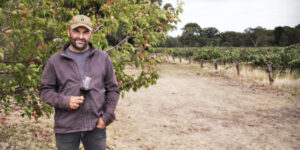
Hither & Yon Wines, SA
Hailing from South Australia’s famed McLaren Vale wine region, Hither & Yon offers a wide range of award-winning, red, white, rosé, and sparkling carbon neutral wines that will pair perfectly with your holiday meals or go down a treat at your office party.
Hither & Yon has placed sustainability at the heart of its operations. In addition to being South Australia’s first carbon neutral winery, the Leask brothers have adopted regenerative farming practices across their vineyards, achieved Sustainable Winegrowing Australia certification, and are transforming part of their growing land into havens for native flora and fauna – Hither & Yon’s ‘Wildlife for Wine’ initiative.
Learn more:
- See more on second generation wine producers: Malcolm and Richard Leask.
- Take a look at Hither & Yon wines.
- Read more about Hither & Yon’s closed loop approach to winemaking.
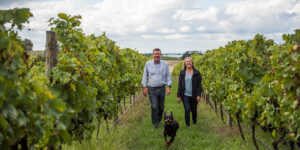
Ross Hill Wines, NSW
Whether you are after a refined, medium-bodied red for a long lunch or something lighter for a lazy Summer afternoon, Ross Hill can help. The wine grower offers a selection of carbon neutral red, white, and rosé wines from one of Australia’s up and coming cool-climate wine regions.
Located in Orange, NSW, Ross Hill Wines is the first in its industry to be Climate Active carbon neutral certified. Continuing to find new ways to offset carbon emissions, they are now looking at a 50-acre native tree planting program on the Wallace Lane vineyard and also investigating ways to re-use waste from grape skins and seeds.
Learn more:
- See more on second generation wine producers: James and Chrissy Robson.
- Take a look at Ross Hill wines.

Capital Brewing Co, ACT
If a cold brew on a hot summer afternoon is more your style, try Capital Brewing Co.’s certified carbon neutral Good Natured Brews. And best of all, you can enjoy a tinnie in the comfort of your own backyard or a schooner fresh from the source at the Fyshwick-based taproom and at over 300 pubs on the East Coast.
Capital Brewing Co. is the only Australian brewery to have its entire beer range certified under the Climate Active program. Sustainability has been integrated throughout the business which uses 100% renewable electricity in the brewing process and diverts a significant proportion of waste product – spent grain, hops, and yeast – to a local organic compost facility. Importantly, Capital Brewing Co. is one of only three Australian breweries to become a certified B Corp.
Learn more:
- Read about fellow Canberrans and co-founders: Tom Hertel and Laurence Kain Grew.
- Visit the Capital Brewing Co. website.
- Read the Capital Brewing Co. case study.
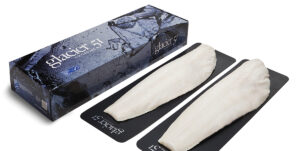
Austral Fisheries
If you forgo a traditional roast during the holiday for a prawn on the barbie, then try Austral Fisheries’ sustainably sourced, carbon neutral tiger and banana prawns.
Austral Fisheries is the world’s first certified carbon neutral seafood business. The organisation plants over 220,000 trees each year and supports Canopy Blue projects that through lab-grown seaweed reforest the ocean floor, sequester carbon, and produce biofuels, food, and other products.
Critical for the health of the industry and the waterways, Austral Fisheries has also partnered with government agencies to remove discarded fishing equipment from Australia’s oceans. The company’s fisheries and wild-caught products are also Marine Stewardship Council certified as sustainable and well managed.
Learn more:
- Read about an Australian company delivering seafood around the world for over 50 years.
- Visit the Austral Fisheries website.
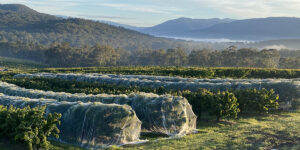
Yarra Valley Cherries, VIC
If there is one thing that speaks to an Australian summer it is biting into a fresh, juicy cherry. One of the best ways to get premium, sustainably grown cherries delivered direct to your door is through Yarra Valley Cherries’ beautifully designed celebration gift boxes.
Yarra Valley Cherries is a family-owned, Climate Active-certified premium grower with more than 20,000 cherry trees. Sustainability is a focus of the business’ operations which includes a fleet of electric forklifts powered by an on-site solar installation and surrounding native forests that serve as a carbon sink in regional Victoria.
Learn more:
